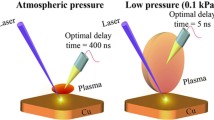Abstract
When compared to many other sensitive methods for material detection, such as inductively coupled mass spectroscopy and thermal ionization mass spectroscopy, laser-induced breakdown spectroscopy (LIBS) typically exhibits a lower signal-to-noise ratio (SNR), resulting in higher detection limits. Increasing the SNR of LIBS would improve the ability to characterize the sample composition with increased accuracy and speed and reduce the amount of material needed to perform analysis. We have been investigating the effect of simple ultrashort laser pulse shaping on the SNR of LIBS. Our goal is to control the dynamics of the ionization and recombination processes in the laser-produced plasma to favorably affect the SNR associated with the line emission from the plasma. Pulse shaping is performed using an acousto-optic programmable dispersive filter. An adaptive learning algorithm is being developed to automate the pulse shape optimization process for maximization of LIBS SNR in nuclear security-relevant material characterization scenarios. We report a 27 % increase of the SNR for non-gated LIBS measurements of uranium by utilizing simple pulse shaping limited exclusively to excess quadratic spectral phase of the laser pulse.









Similar content being viewed by others
References
Pasquini C, Cortex J, Silva LMC, Gonzaga FB (2008) Appl Opt 47:G105
Santagata A, Teghil R, Albano G, Spera D, Villani P, De Bonis A, Parisi GP, Galasso A (2007) Appl Surf Sci 254:863
Bogarerts A, Chen Z (2005) Spec Acta B 60:1280
Fantoni R, Caneve L, Colao F, Fornarini L, Lazic V, Spizzichino V (2002) Spec Acta B 57:1219
Therstup BB, Toftmann JS, Doggett B, Lunney J (2002) Appl Surf Sci 197–198:175
Teghil R, Santagata A, De Bonis A, Albano G, Villani P, Spera D, Parisi GP, Galasso A (2008) Phys Scr 78:058113
Multari RA, Foster LE, Cremers DA, Ferris MJ (1996) Appl Spec 50:1483
Le Drogoff B, Margot J, Chaker M, Sabsabi M, Barthelemy O, Johnston TW, Laville S, Vidal F, Von Kaenel Y (2001) Spec Acta B 56:987
De Giacomo A, Dell’agilo M, Santagata A, Teghil R (2005) Spec Acta B 60(31):935
Angel SM, Stratis DN, Eland KL, Lai T, Berg MA, Gold DM (2001) Fresenius J Anal Chem 369:320
Hwang DJ, Jeon H, Grigoropoulos CP, Yoo J, Russo RE (2007) Appl Phys Lett 91:251118
Gunaratne T, Kangas M, Singh S, Gross A, Dantus M (2006) Chem Phys Lett 423:197
Elhassan A, Giakoumaki A, Anglos D, Ingo GM, Robbiola L, Harith MA (2008) Spec Acta B 63(4):504
Baudelet M, Guyon L, Yu J, Wolf J-P, Amodeo T, Frehafon E, Laloi P (2006) J Appl Phys 99:084701
Guillermin M, Liebig C, Garrelie F, Stoian R, Loir A-S, Audouard E (2009) Appl Surf Sci 255(10):5163
Guillermin M, Klini A, Colobier J-P, Garrelie F, Gray D, Liebig C, Audouard E, Fotakis C, Stoian R (2010) Opt Express 18:11159
Qiu TQ, Tien CL (1992) Int J Heat Mass Trans 35:719
Acknowledgments
This research was performed under the Nuclear Forensics Graduate Fellowship Program and the Nuclear Forensics Junior Faculty Award, which are sponsored by the US Department of Homeland Security Domestic Nuclear Detection Office and the US Department of Defense, Defense Threat Reduction Agency. The authors would also like to acknowledge The Pennsylvania State University Radioactive Material Safety Program for their assistance in acquiring uranium samples for this research.
Author information
Authors and Affiliations
Corresponding author
Rights and permissions
About this article
Cite this article
Hartig, K.C., McNutt, J.P., Ko, P. et al. Pulse chirp effects in ultrafast laser-induced breakdown spectroscopy. J Radioanal Nucl Chem 296, 135–141 (2013). https://doi.org/10.1007/s10967-012-2038-x
Received:
Published:
Issue Date:
DOI: https://doi.org/10.1007/s10967-012-2038-x




